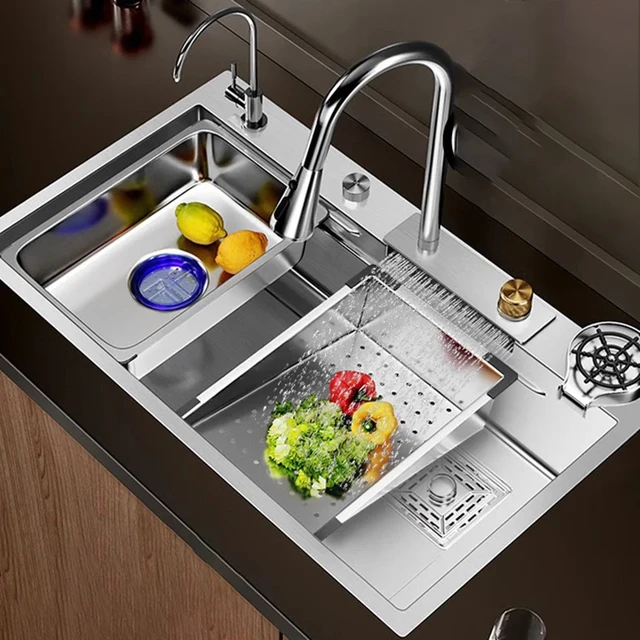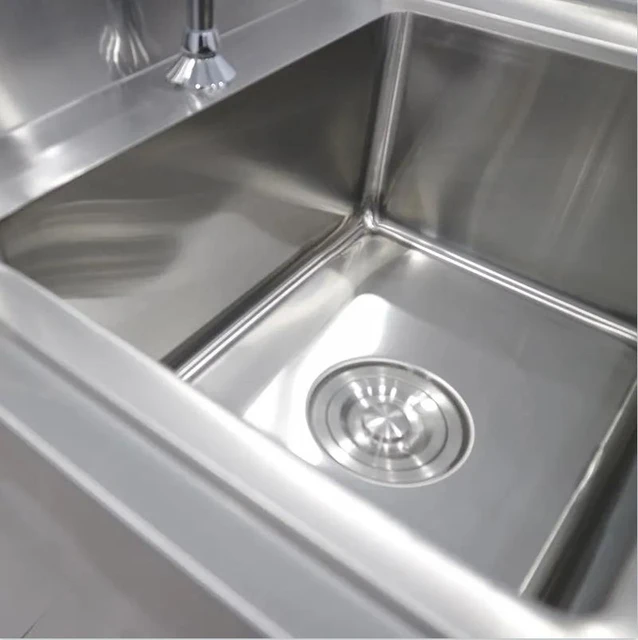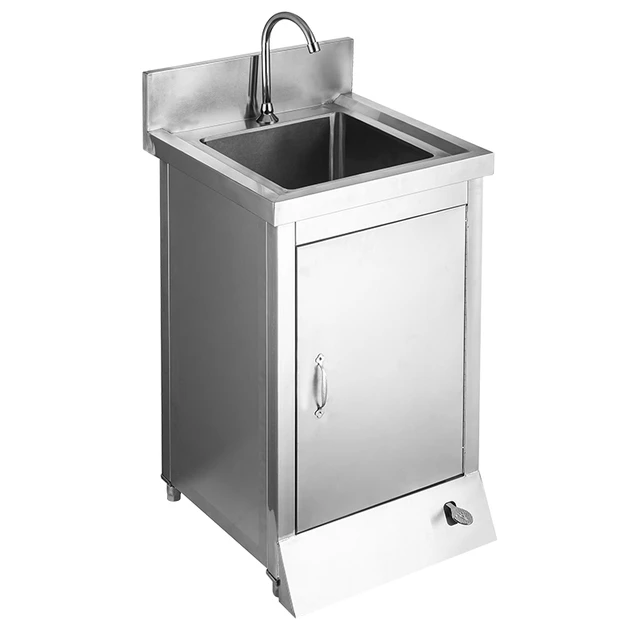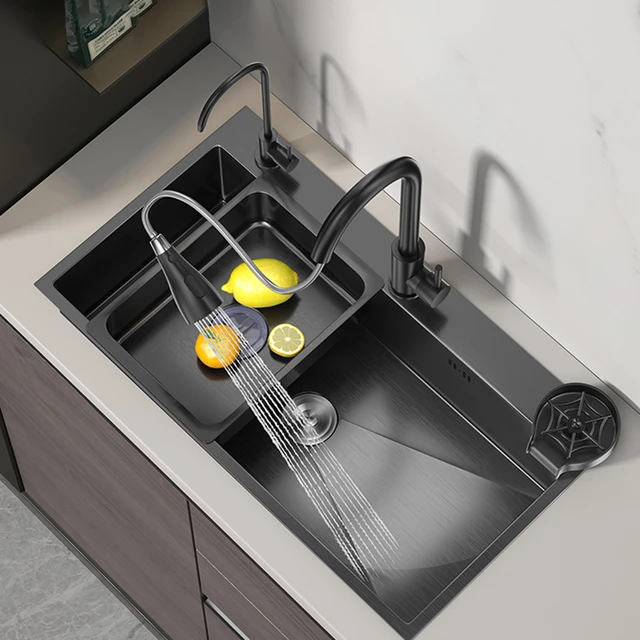 Introduction:
Introduction:
Commercial kitchen sinks are essential fixtures in professional foodservice establishments, providing a dedicated space for washing, rinsing, and sanitizing cookware, utensils, and ingredients. They are designed to withstand heavy use and facilitate efficient food preparation and cleanup. In this comprehensive guide, we will explore the various types, features, and considerations when choosing commercial kitchen sinks. By understanding the options available and the factors to consider, you can select the right sink that meets the specific needs of your commercial kitchen.
 Types of Commercial Kitchen Sinks:
Types of Commercial Kitchen Sinks:
Single Compartment Sinks:
Single compartment sinks have one large basin for washing, rinsing, and sanitizing dishes and utensils.
They are space-efficient and commonly used in smaller commercial kitchens or areas with limited space.
Double Compartment Sinks:
Double compartment sinks have two separate basins, allowing for multitasking and separating tasks.
They are commonly used for dishwashing and food preparation in larger commercial kitchens.
Triple Compartment Sinks:
Triple compartment sinks have three basins, providing even more versatility for dishwashing, food preparation, and rinsing.
They are ideal for high-volume kitchens or establishments with a large amount of cookware and utensils.
Handwashing Sinks:
Handwashing sinks are specifically designed for employees to wash their hands, promoting hygiene and preventing cross-contamination.
They are required by health codes and regulations and should be easily accessible in the kitchen.
 Sink Materials:
Sink Materials:
Stainless Steel:
Stainless steel sinks are the most common and preferred choice in commercial kitchens.
They are durable, resistant to corrosion and stains, easy to clean, and can withstand heavy use.
Cast Iron:
Cast iron sinks offer exceptional durability and heat resistance.
They are less common in commercial kitchens due to their weight and potential for chipping or cracking.
Composite Granite:
Composite granite sinks are a durable and attractive option.
They are resistant to scratches, stains, and heat, making them suitable for commercial kitchens.
 Considerations for Choosing Commercial Kitchen Sinks:
Considerations for Choosing Commercial Kitchen Sinks:
Size and Configuration:
Consider the available space and the specific needs of your kitchen when choosing the size and configuration of the sink.
Ensure there is ample room for washing, rinsing, and sanitizing dishes, as well as for food preparation tasks.
Faucet Compatibility:
Check the compatibility of the sink with various faucet types and configurations.
Consider the specific needs of your kitchen and any regulations or requirements regarding faucet installation.
Drainboards:
Drainboards are extensions of the sink that provide space for drying dishes and utensils.
Determine whether a sink with built-in drainboards or separate drainboards is necessary for your kitchen’s workflow.
NSF Certification:
Look for sinks with NSF certification, indicating they meet strict standards for quality, durability, and sanitation.
NSF-certified sinks are essential for meeting health code regulations in commercial kitchens.
Sink Maintenance and Care:
Regular Cleaning:
Clean the sink regularly using appropriate cleaning agents and a brush or sponge.
Pay attention to the drain and crevices where food particles and debris may accumulate.
Avoid Harsh Chemicals:
Avoid using harsh chemicals or abrasive cleaners that can damage the sink’s surface.
Opt for mild detergents or specialized stainless steel cleaners for routine cleaning.
Preventative Maintenance:
Inspect the sink regularly for any signs of damage, leaks, or loose fittings.
Repair or replace any damaged components promptly to prevent further issues.
Plumbing Maintenance:
Properly maintain the plumbing connected to the sink, including checking for leaks, clearing clogs, and ensuring proper water flow.
Schedule routine inspections and maintenance by a qualified plumber to prevent plumbing-related issues.
Some tips for pairing sinks with kitchen designs:
When it comes to designing a kitchen that incorporates a sink, there are several factors to consider for optimal functionality and style. Here are some tips for pairing sinks with kitchen designs:
Sink Placement:
Determine where the sink will be located in your kitchen design. The most common placement is along the kitchen countertop, usually underneath a window or in an island. Consider the flow of work in the kitchen and ensure that the sink is conveniently positioned between the cooking and food preparation areas.
Size and Style:
Choose a sink size and style that fits well with the overall design aesthetic of your kitchen. For a contemporary look, consider a sleek stainless steel or granite composite sink. For a more traditional or farmhouse-inspired design, an apron front or porcelain sink might be a better choice.
Sink Configuration:
Decide on the configuration of the sink. The most common options are single bowl, double bowl, or even triple bowl sinks. Determine your specific needs and preferences for washing dishes, food preparation, and other kitchen tasks.
Sink Materials:
Select a sink material that suits your functional requirements and design preferences. Stainless steel is popular for its durability and resistance to stains and heat. Other materials like porcelain, composite, or granite offer a variety of colors and finishes to match your kitchen aesthetics.
Faucet Style:
Consider the style and finish of the faucet that will accompany the sink. Ensure that it complements the overall design of your kitchen. Choose a faucet that offers the desired features, such as a pull-out spray head or touchless operation, based on your needs and preferences.
Accessories and Extras:
Explore the available accessories and extras that can enhance the functionality of your sink. These include cutting boards, sink grids, colanders, soap dispensers, and garbage disposal systems. Incorporating these elements can make your sink area more efficient and organized.
Lighting and Ventilation:
Plan appropriate lighting above the sink area to ensure good visibility for washing dishes and food preparation. Additionally, consider installing a ventilation system, such as a range hood, to prevent excess moisture and odors from accumulating around the sink area.
Remember, the design and integration of the sink in your kitchen should prioritize functionality, ease of use, and visual appeal. Consider your specific needs, design preferences, and budget to create a kitchen that seamlessly incorporates a sink that meets your requirements.
 Conclusion:
Conclusion:
Commercial kitchen sinks play a vital role in food preparation and cleanliness in professional foodservice establishments. By choosing the right type, size, and material of sink for your commercial kitchen, you can ensure efficient workflow, proper sanitation, and durability. Consider the size and configuration of the sink, compatibility with faucets, presence of drainboards, and NSF certification when making your selection. Regular cleaning and maintenance of the sink and plumbing system will prolong its lifespan and maintain hygienic conditions. With a well-chosen and properly maintained commercial kitchen sink, you can enhance productivity, cleanliness, and overall operational efficiency in your foodservice establishment.


